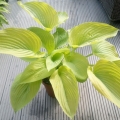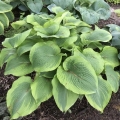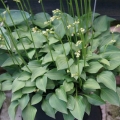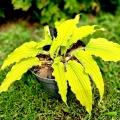Online Shop
130
Royal Horticultural Society
Gold Medals
Royal Horticultural Society
Gold Medals
- Home
- About Bowdens
- Paul Whittaker
- The New Bamboo by Val Bourne - The Daily Telegraph 2 February 2007
The New Bamboo by Val Bourne - The Daily Telegraph 2 February 2007
Not every bamboo is a rampant space-invader. Val Bourne talks to an expert grower for tips on the most desirable varieties, where to place them and ideal planting companions
Bamboo looks gorgeous when lit by winter sun. The low light give a lacquer to the cane and warms the avocado-green of their elegant leaves. These, in turn, tremble attractively when the wind blows through them, and cast a flickering pattern of light and shade, like a huge magic lantern at play.
It seems strange, then, that most gardeners are wary of bamboo. We have been put off by the rampant spreading of varieties from the lowland plains of China, introduced in the late 19th century, many of which have run wild to create walk-through groves in large gardens. What if they were to turn our gardens into an impenetrable jungle?
In the past 20 years, however, bamboos have been introduced from the cold, mountainous regions of Chile and the Himalayas. These high-altitude varieties are not aggressive spreaders, but rather form clumps of limited size. Some are suitable for small gardens, although all bamboos need space to really shine.
Paul Whittaker, from PW Plants in Norfolk, has done as much as anyone to make these new introductions popular through his Gold Medal displays at Chelsea and other leading flower shows. He has also written an award-winning book, Hardy Bamboos: Taming the Dragon, which gives reassuring advice about their eventual height and spread.
There are only three genera that Whittaker recommends as clump-formers: fargesia, chusquea and thamnocalamus. Fargesias come from upland areas of China and have thin, colourful canes topped by a fountain of fine foliage. These arching bamboos can be grown in containers as well as in the garden, although they must never dry out.
Fargesia rufa, introduced in the past 15 years, is one of the showiest. Its foliage has an unusual blue-green glow. Each slender green cane is banded with colourful sheaths that vary from orange-red to shrimp-pink, depending on the soil. "More alkaline soil produces brighter sheaths," says Whittaker. In 10 years, Fargesia rufa will grow to a maximum height of 2.5m (8ft), in a clump up to 1.2m (4ft) wide.
Whittaker rates the more spectacular, strongly vertical Fargesia robusta as "one of the top five bamboos". Its thick canes, of a warm shade of green, reach a height of 5m (16ft) in five or six years and are banded with clean, paper-white sheaths in summer. The contrast of white and green makes this bamboo a must-have. It will form a tight clump 1.5m (5ft) wide in 10 years.
Most species of thamnocalamus are from the higher reaches of the Himalayas and like it cool, but they need shelter from both sun and wind. The star is Thamnocalamus crassinodus 'Kew Beauty': its canes have a sky-blue bloom. Patience is needed, because young plants take time to establish. It grows to 4m (13ft) in height and the spread after 10 years is 2m (5ft).
The chusqueas are from the Chilean Andes, where the climate is cool and the rainfall high. They form open clumps and grow quickly. The most refined, in Whittaker's opinion, is Chusquea culeou, an elegant, arching bamboo with small leaves and deep-green canes. After 10 years, it should reach 4m (13ft) in height and achieve a width of 2m (5ft).
Although these clump-formers are easier to handle, there is still a role for aggressive, spreading bamboos, says Whittaker, in a large garden. "If you want to contain a slippery bank, there is nothing better for binding the soil and preventing erosion," he says. He has a form of Sasa veitchii that came from Beth Chatto's garden, where she uses it to cover a slope beside a pond. It is grown not for its purplish canes, but for its interestingly coloured oval leaves, which look especially dramatic in winter. "Each leaf has a bleached cream edge, and the bleached area spreads as the temperatures drop," says Whittaker.
The tall, very upright Pseudosasa japonica, meanwhile, is perfect for forming a grove or high windbreak. It has pale-green canes, each as thick as your thumb, with straw-coloured sheaths. It reaches a height of 4m (13ft) and a spread of 3m (10ft) in 10 years.
With roughly half of all bamboos, their growth habit depends on climate and soil. In this country, their growth is more vigorous in south-west England, where summers are humid, winters warm and light levels high. In East Anglia, where it is dry in summer and cold in winter, the same plant might reach just half the size.
Among these uncertain varieties is Phyllostachys nigra, the most spectacular member of the most desirable group of bamboos, all of which have colourful canes. "More often than not, Phyllostachys nigra is a tight bamboo," says Whittaker, "reaching a height of 6m (20ft) and a spread of 1.5m (5ft), but growth will vary according to location." Its black canes are accentuated by narrow white rings.
Another of Whittaker's favourites is Phyllostachys vivax f. aureocaulis, which forms tight clumps up to 10m (33ft) high. But his desert island bamboo is Phyllostachys aureosulcata f. spectabilis. Each custard-yellow cane is grooved with deep green, and this bamboo can produce zigzagged canes as well as straight ones. It colours up best in harsh, exposed positions and the dark-green foliage provides a striking contrast with the gold and green canes.
Bamboo looks gorgeous when lit by winter sun. The low light give a lacquer to the cane and warms the avocado-green of their elegant leaves. These, in turn, tremble attractively when the wind blows through them, and cast a flickering pattern of light and shade, like a huge magic lantern at play.
It seems strange, then, that most gardeners are wary of bamboo. We have been put off by the rampant spreading of varieties from the lowland plains of China, introduced in the late 19th century, many of which have run wild to create walk-through groves in large gardens. What if they were to turn our gardens into an impenetrable jungle?
In the past 20 years, however, bamboos have been introduced from the cold, mountainous regions of Chile and the Himalayas. These high-altitude varieties are not aggressive spreaders, but rather form clumps of limited size. Some are suitable for small gardens, although all bamboos need space to really shine.
Paul Whittaker, from PW Plants in Norfolk, has done as much as anyone to make these new introductions popular through his Gold Medal displays at Chelsea and other leading flower shows. He has also written an award-winning book, Hardy Bamboos: Taming the Dragon, which gives reassuring advice about their eventual height and spread.
There are only three genera that Whittaker recommends as clump-formers: fargesia, chusquea and thamnocalamus. Fargesias come from upland areas of China and have thin, colourful canes topped by a fountain of fine foliage. These arching bamboos can be grown in containers as well as in the garden, although they must never dry out.
Fargesia rufa, introduced in the past 15 years, is one of the showiest. Its foliage has an unusual blue-green glow. Each slender green cane is banded with colourful sheaths that vary from orange-red to shrimp-pink, depending on the soil. "More alkaline soil produces brighter sheaths," says Whittaker. In 10 years, Fargesia rufa will grow to a maximum height of 2.5m (8ft), in a clump up to 1.2m (4ft) wide.
Whittaker rates the more spectacular, strongly vertical Fargesia robusta as "one of the top five bamboos". Its thick canes, of a warm shade of green, reach a height of 5m (16ft) in five or six years and are banded with clean, paper-white sheaths in summer. The contrast of white and green makes this bamboo a must-have. It will form a tight clump 1.5m (5ft) wide in 10 years.
Most species of thamnocalamus are from the higher reaches of the Himalayas and like it cool, but they need shelter from both sun and wind. The star is Thamnocalamus crassinodus 'Kew Beauty': its canes have a sky-blue bloom. Patience is needed, because young plants take time to establish. It grows to 4m (13ft) in height and the spread after 10 years is 2m (5ft).
The chusqueas are from the Chilean Andes, where the climate is cool and the rainfall high. They form open clumps and grow quickly. The most refined, in Whittaker's opinion, is Chusquea culeou, an elegant, arching bamboo with small leaves and deep-green canes. After 10 years, it should reach 4m (13ft) in height and achieve a width of 2m (5ft).
Although these clump-formers are easier to handle, there is still a role for aggressive, spreading bamboos, says Whittaker, in a large garden. "If you want to contain a slippery bank, there is nothing better for binding the soil and preventing erosion," he says. He has a form of Sasa veitchii that came from Beth Chatto's garden, where she uses it to cover a slope beside a pond. It is grown not for its purplish canes, but for its interestingly coloured oval leaves, which look especially dramatic in winter. "Each leaf has a bleached cream edge, and the bleached area spreads as the temperatures drop," says Whittaker.
The tall, very upright Pseudosasa japonica, meanwhile, is perfect for forming a grove or high windbreak. It has pale-green canes, each as thick as your thumb, with straw-coloured sheaths. It reaches a height of 4m (13ft) and a spread of 3m (10ft) in 10 years.
With roughly half of all bamboos, their growth habit depends on climate and soil. In this country, their growth is more vigorous in south-west England, where summers are humid, winters warm and light levels high. In East Anglia, where it is dry in summer and cold in winter, the same plant might reach just half the size.
Among these uncertain varieties is Phyllostachys nigra, the most spectacular member of the most desirable group of bamboos, all of which have colourful canes. "More often than not, Phyllostachys nigra is a tight bamboo," says Whittaker, "reaching a height of 6m (20ft) and a spread of 1.5m (5ft), but growth will vary according to location." Its black canes are accentuated by narrow white rings.
Another of Whittaker's favourites is Phyllostachys vivax f. aureocaulis, which forms tight clumps up to 10m (33ft) high. But his desert island bamboo is Phyllostachys aureosulcata f. spectabilis. Each custard-yellow cane is grooved with deep green, and this bamboo can produce zigzagged canes as well as straight ones. It colours up best in harsh, exposed positions and the dark-green foliage provides a striking contrast with the gold and green canes.
New Additions
-
Wundergold £15.00

-
Unruly Child £14.00

-
Twin Cities £11.00

-
venusta 'Porter' £8.00

-
Valley's Love Birds £10.00





